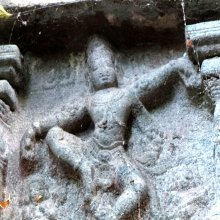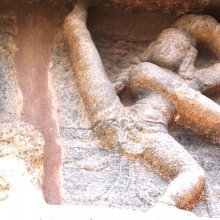Dandapaksha, Daṇḍapakṣa, Danda-paksha, Damdapaksha: 4 definitions
Introduction:
Dandapaksha means something in Hinduism, Sanskrit. If you want to know the exact meaning, history, etymology or English translation of this term then check out the descriptions on this page. Add your comment or reference to a book if you want to contribute to this summary article.
The Sanskrit term Daṇḍapakṣa can be transliterated into English as Dandapaksa or Dandapaksha, using the IAST transliteration scheme (?).
Images (photo gallery)
In Hinduism
Natyashastra (theatrics and dramaturgy)
Source: Wisdom Library: Nāṭya-śāstra1) Daṇḍapakṣa (दण्डपक्ष).—One of the 108 karaṇas (minor dance movement) mentioned in the Nāṭyaśāstra chapter 4. The instructions for this daṇḍapakṣa-karaṇa is as follows, “observing Ūrdhvajānu Cārī, Latā hands to be placed on the knee.”. A karaṇa represents a minor dance movements and combines sthāna (standing position), cārī (foot and leg movement) and nṛttahasta (hands in dancing position).
2) Daṇḍapakṣa (दण्डपक्ष) also refers to a gesture (āṅgika) made with ‘dance hands’ (nṛttahasta), according to the Nāṭyaśāstra chapter 8. The hands (hasta) form a part of the human body which represents one of the six major limbs (aṅga) used in dramatic performance. With these limbs are made the various gestures (āṅgika), which form a part of the histrionic representation (abhinaya).
Source: archive.org: Natya ShastraDaṇḍapaksa (दण्डपक्स).—A type of gesture (āṅgika) made with dance-hands (nṛttahasta);—(Instructions): The two Haṃsapakṣa hands moved alternately and then held out like a staff. The Dance-hands are to be used in forming Karaṇas.
Source: Shodhganga: Elements of Art and Architecture in the Trtiyakhanda of the Visnudharmottarapurana (natya)1) Daṇḍapakṣa (दण्डपक्ष) refers to one of the thirty Nṛttahastas or “dance hand gestures” (in Indian Dramas), according to the Viṣṇudharmottarapurāṇa, an ancient Sanskrit text which (being encyclopedic in nature) deals with a variety of cultural topics such as arts, architecture, music, grammar and astronomy.—The hasta-mudrās (lit. “hand-gestures”) are very essential to denote some particular action or state in dancing and these mudrās are formed with the help of hands and fingers. In the Viṣṇudharmottarapurāṇa, thirty kinds of nṛttahastas (“dance-hand gestures”) are mentioned. e.g., daṇḍapakṣa. The practice of these nṛttahastas is strictly prohibited in sickness of body, in old age, in fear, drunk and anxiety.
2) Daṇḍapakṣa (दण्डपक्ष) refers to one of the 108 kinds of Karaṇa (“coordination of precise movements of legs and hands”), according to the Viṣṇudharmottarapurāṇa.—Accordingly, karaṇas are the coordination of precise movements of legs and hands performed in a particular posture. The Nāṭyaśāstra also gives its view point in the same spirit. In the Viṣṇudharmottarapurāṇa, one hundred and eight kinds of karaṇas are accepted, e.g., Daṇḍapakṣa.

Natyashastra (नाट्यशास्त्र, nāṭyaśāstra) refers to both the ancient Indian tradition (shastra) of performing arts, (natya—theatrics, drama, dance, music), as well as the name of a Sanskrit work dealing with these subjects. It also teaches the rules for composing Dramatic plays (nataka), construction and performance of Theater, and Poetic works (kavya).
Languages of India and abroad
Kannada-English dictionary
Source: Alar: Kannada-English corpusDaṃḍapakṣa (ದಂಡಪಕ್ಷ):—
1) [noun] (dance.) a posture in which the body is bent slightly at the waist, holding one palm in the shape of a swan at the breast, stretching the elbow out, and the other arm hung slightly away from the body with the hand hanging loosely.
2) [noun] (dance) another posture in which standing on one foot, raising the other leg bending it at the knee with one palm kept on that knee and the other arm hung slightly away from the body with the hand hanging loosely.
Kannada is a Dravidian language (as opposed to the Indo-European language family) mainly spoken in the southwestern region of India.
See also (Relevant definitions)
Partial matches: Paksha, Danda, Tanta.
Starts with: Dandapakshahasta, Dandapakshaka.
Full-text: Nrittahasta, Dandapakshahasta.
Relevant text
Search found 3 books and stories containing Dandapaksha, Daṇḍapakṣa, Danda-paksha, Damdapaksha, Daṇḍa-pakṣa, Danda-paksa, Dandapaksa, Daṇḍapaksa, Daṃḍapakṣa, Damdapaksa; (plurals include: Dandapakshas, Daṇḍapakṣas, pakshas, Damdapakshas, pakṣas, paksas, Dandapaksas, Daṇḍapaksas, Daṃḍapakṣas, Damdapaksas). You can also click to the full overview containing English textual excerpts. Below are direct links for the most relevant articles:
Vishnudharmottara Purana (Art and Architecture) (by Bhagyashree Sarma)
2.2. Hand Postures (c): Nṛtta-hasta < [Chapter 3 - Drama and Dance]
2.5. Karaṇa (movements of legs and hands) < [Chapter 3 - Drama and Dance]
Shishupala-vadha (Study) (by Shila Chakraborty)
Bhoga-vyūha (Snake array): < [Chapter 6 - Principles of Warfare]
Natyashastra (English) (by Bharata-muni)

